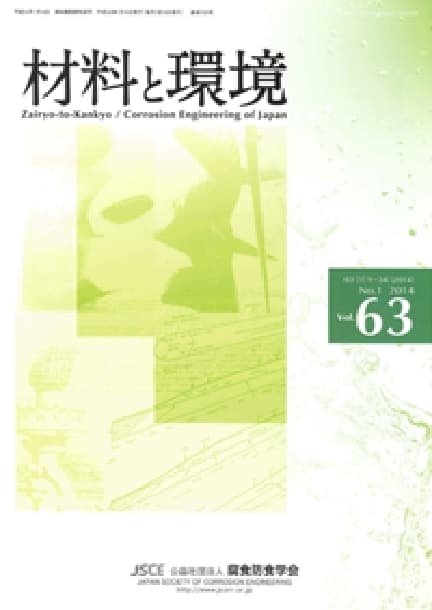- TOP
- Zairyo-to-Kankyo
- Vol. 68 (2019), No. 1
Zairyo-to-Kankyo Vol. 68 (2019), No. 1
Backnumber
-
Vol. 74 (2025)
-
Vol. 73 (2024)
-
Vol. 72 (2023)
-
Vol. 71 (2022)
-
Vol. 70 (2021)
-
Vol. 69 (2020)
-
Vol. 68 (2019)
-
Vol. 67 (2018)
-
Vol. 66 (2017)
-
Vol. 65 (2016)
-
Vol. 64 (2015)
-
Vol. 63 (2014)
-
Vol. 62 (2013)
-
Vol. 61 (2012)
-
Vol. 60 (2011)
-
Vol. 59 (2010)
-
Vol. 58 (2009)
-
Vol. 57 (2008)
-
Vol. 56 (2007)
-
Vol. 55 (2006)
-
Vol. 54 (2005)
-
Vol. 53 (2004)
-
Vol. 52 (2003)
-
Vol. 51 (2002)
-
Vol. 50 (2001)
-
Vol. 49 (2000)
-
Vol. 48 (1999)
-
Vol. 47 (1998)
-
Vol. 46 (1997)
-
Vol. 45 (1996)
-
Vol. 44 (1995)
-
Vol. 43 (1994)
-
Vol. 42 (1993)
-
Vol. 41 (1992)
-
Vol. 40 (1991)
Keyword Ranking
14 Dec. (Last 30 Days)
Zairyo-to-Kankyo Vol. 68 (2019), No. 1
Ⅳ. Electrochemical Measurements in Various Environments―Nuclear Power Plant I (Electrochemical Measurement in Nuclear Power Plant)―
Fumiyoshi Ueno
pp. 2-8
DOI:
10.3323/jcorr.68.2Abstract
It is important to control the cooling water of light water reactors (boiling water reactor and pressurized water reactor) to suitable quality in order to reduce corrosion of structural materials and generation of radioactive corrosion products. For that purpose, monitoring of water quality using electrochemical measurement method is necessary. In this article, the application of ECP measurement to BWR is mainly focused, I describe the water quality of light water reactors and the necessity of electrochemical measurement.
Readers Who Read This Article Also Read
Zairyo-to-Kankyo Vol.47(1998), No.3
Long Term Exposure Test and Corrosion Evaluation of Hot Dip Coated and Painted Steel Sheets in Actual Steel Industrialized Housing
Shin-ichi Motoda, Kuniyasu Araga, Norihito Ikeda, Toshihiko Ooi, Takeshi Shimizu, Kiyotaka Suzuki, Hiromasa Nomura, Tsuyoshi Matsumoto, Masamitsu Matsumoto
pp. 9-24
DOI:
10.3323/jcorr.68.9Abstract
Japan society of corrosion engineering has continued the subcommittee activities (the name of the current session: subcommittee of the indoor corrosion) based on the keyword “corrosion of hot dip coated and painted steel sheet in the housing environment” since 1995. Among them, in the laboratory test and the actual housing exposure test, a salt adhesion test was carried out by adhere a certain amount of sea salt in advance to the corrosion in exposure test, and the corrosion rate of the hot dip coated steel sheet and the painted steel sheet were measured by meanings of precise measurement and surface analysis. This paper explained the lifetime evaluation method of these steel sheets used in the structural framework for housing. On the hot dip coated steel sheet, although there is a difference in the corrosion rate in the laboratory test and the simulated test box exposure test and the in-house exposure test, the lifetime of various hot dip coated steel sheets in the house can be predicted with amount the amount of deposited sea salt (Cl-). The possibility was shown that for the painted steel sheet, in addition to the blister of coating, the red rust width also be an index that can evaluate the corrosion condition under the residential environment by the reason that the red rust width and the maximum corrosion depth under the paint film are indicating a positive correlation.
Readers Who Read This Article Also Read
Zairyo-to-Kankyo Vol.66(2017), No.1
Tetsu-to-Hagané Vol.59(1973), No.10
Tetsu-to-Hagané Vol.56(1970), No.7
Effect of Fe3+ on Corrosion Behavior of 5083 Aluminum Alloy in Neutral Environment
Ippei Shinozaki, Yohei Sakakibara, Gen Nakayama
pp. 28-32
DOI:
10.3323/jcorr.68.28Abstract
In order to investigate the effect of Fe3+ on corrosion resistance of 5083 aluminum alloy (A5083) in aqueous solution, electrochemical tests and surface observations were carried out in various solution. Open Circuit Potential (OCP) of the alloy in the solution containing Fe3+ shifted to the less-noble direction regardless of the anionic species such as Cl- and SO42-. From the polarization curves and the result of surface observation, the effect of Fe3+ on the surface of A5083 was suggested that the Fe3+ reduction reaction predominantly occurred on compounds.Anodic reaction around the compounds possibly increased to balance the cathodic reaction. It caused the OCP shifting and the dissolution around compounds.
Article Access Ranking
14 Dec. (Last 30 Days)
-
Delayed Fracture Mechanism of 1700 MPa-Class Quenched and Tempered Bolt under Atmospheric Corrosion Environment
Tetsu-to-Hagané Advance Publication
-
Perspectives on the Promising Pathways to Zero Carbon Emissions in the Steel Industry toward 2050
ISIJ International Vol.65(2025), No.2
-
Effect of B on Surface Oxidation Behavior and Phosphatability of Si-Mn-added Cold-Rolled Steel Sheets
ISIJ International Advance Publication
-
Factors Influencing the Bonding Phase Structure of Iron Ore Sinters
ISIJ International Vol.43(2003), No.9
-
Effect of microstructural heterogeneity on fatigue limit of as-quenched low-carbon low-alloy martensitic steel
ISIJ International Advance Publication
-
Prussian blue as a fully reversible hydrogenochromic material for visualizing hydrogen distribution in Fe sheet
ISIJ International Advance Publication
-
Progress of Strip Casting Technology for Steel; Historical Developments
ISIJ International Vol.52(2012), No.12
-
Research Progress on Optimal Blending of Iron Ore Powders for Sintering
ISIJ International Vol.65(2025), No.12
-
-
Microstructures and Reduction Properties of High CaO Concentration Sintered Ore
ISIJ International Advance Publication
You can use this feature after you logged into the site.
Please click the button below.










